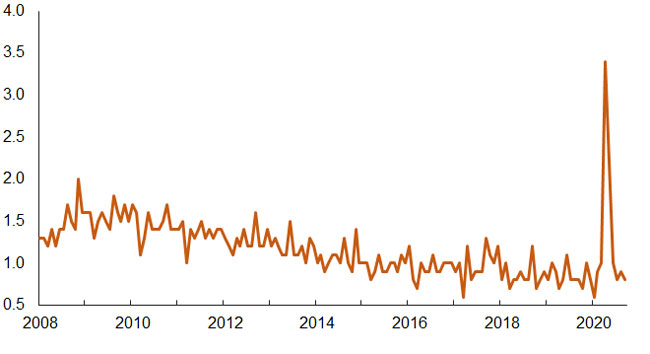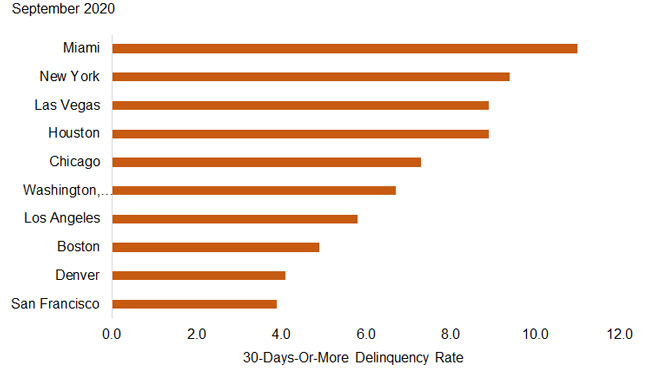
In September 2020, 6.3% of home mortgages were in some stage of delinquency (30 days or more past due, including those in foreclosure)[1], a small decrease from August 2020, but a 2.5-percentage point increase from September 2019, according to the latest CoreLogic Loan Performance Insights Report.
The share of mortgages that were 30 to 59 days past due – considered early-stage delinquencies – was 1.5% in September 2020, down sharply from a post-pandemic high of 4.2% in April 2020 and below the year ago rate of 1.9%. The share of mortgages 60 to 89 days past due was 0.7% in September 2020, up from 0.6% in September 2019 and down from 2.8% in May 2020.
The serious delinquency rate – defined as 90 days or more past due, including loans in foreclosure – was 4.2% in September up from 1.3% a year earlier, but down a bit from 4.3% in August 2020. August’s number represented the highest rate since February 2014. The spike in delinquency that began in April has worked its way through the stages of delinquency and is sitting in the 180-days past-due stage, which increased to 1.6% in September, the highest rate since 2014 and more than five times the year ago rate. The CARES Act provides relief to mortgage holders and has worked to keep delinquencies from progressing to foreclosure. The foreclosure inventory rate – the share of mortgages in some stage of the foreclosure process – remained low at 0.3% in September 2020, down from 0.4% from September 2019.
Figure 1: Current- To 30-Day Transition Rate Dropped Back After Peaking In April

In addition to delinquency rates, CoreLogic tracks the rate at which mortgages transition from one stage of delinquency to the next, such as going from current to 30 days past due (Figure 1). The share of mortgages that transitioned from current to 30 days past due dropped to 0.8% in September 2020 – a decrease from the peak of 3.4% in April 2020.
Figure 2: States With the Highest and Lowest Rate of Mortgages At Least 30 Days Past Due

Figure 2 shows the states with the highest and lowest share of mortgages 30 days or more delinquent. In September 2020, that rate was highest in Louisiana at 10.1% and lowest in Idaho at 3.4%. All U.S. states posted annual gains in their overall delinquency rate in September 2020. The states that logged the largest annual increases were Nevada (+4.9 percentage points), Hawaii (+4.7 percentage points), Florida (+4 percentage points) and New Jersey (+3.9 percentage points).
Figure 3: Percentage Of Mortgages At Least 30 Days Past Due For The Ten Largest Metropolian Areas

Figure 3 shows the 30-plus-day past-due rate for September 2020 for 10 large metropolitan areas.[2] Miami had the highest rate at 11% and San Francisco had the lowest rate at 3.9%. Miami’s rate increased 6 percentage points from a year earlier. Outside of the largest 10, all but two metros recorded an increase in the overall delinquency rate. Lake Charles, Lousisiana — where Hurricane Laura hit in August — experienced the largest annual increase of 10.7 percentage points. Other metro areas with significant increases in the overall delinquency rate included Odessa, Texas (up 10.3 percentage points), Midland, Texas (up 7.9 percentage points) and Kahului, Hawaii (up 7.5 percentage points).
To learn more about the data behind this article and what CoreLogic has to offer, visit https://www.corelogic.com/.







Sign up to receive our stories in your inbox.
Data is changing the speed of business. Investors, Corporations, and Governments are buying new, differentiated data to gain visibility make better decisions. Don't fall behind. Let us help.













Sign up to receive our stories in your inbox.
Data is changing the speed of business. Investors, Corporations, and Governments are buying new, differentiated data to gain visibility make better decisions. Don't fall behind. Let us help.





